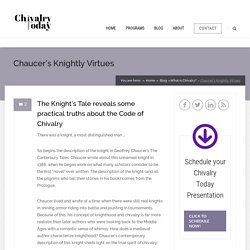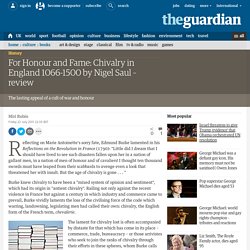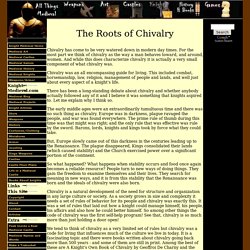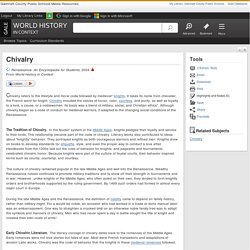

The Reign of Arthur Christopher Gidlow. Courtly love in the work of Chretien de Troyes. Back to Ex Libris Susi Vaasjoki Spring 2001 Like so many things medieval, the matter of courtly love has been subjected to any variety of treatments and mistreatments.

In part this interest probably stems from the radical differences between modern customs and the almost ritualistically codified practices of fin amour as seen in literature; but no small amount of the assorted studies can be attributed to the tug-o-war on how much of popular tradition should be chalked up to poetic licence. To date, the question is still open to debate. This essay will discuss actual, implied and presumed aspects of pre-Renaissance courtly love. Examining courtly love According to Lewis, the concept of courtly love first appeared in Languedoc, France, at the end of the 11th century. As a contemporary phenomenon, courtly love can be seen as both misplaced and eminently appropriate to the age it flourished in. Chivalric Romances: Popular Literature in Medieval England - 1983, Page 232 by Lee C. Ramsey. Chaucer’s Knightly Virtues. The Knight’s Tale reveals some practical truths about the Code of Chivalry There was a knight, a most distinguished man … So begins the description of the knight in Geoffrey Chaucer’s The Canterbury Tales.

Chaucer wrote about this unnamed knight in 1386, when he began work on what many scholars consider to be the first “novel” ever written. History - Geoffrey Chaucer. Full text of "Chivalry" Vol. III: The Age of Chivalry. Bulfinch, Thomas. 1913. Age of Fable. 06.04.01, de Charny, A Knight's Own Book of Chivalry. In 1996, Richard Kaeuper and Elspeth Kennedy published the first scholarly edition of Geoffroi de Charny's Livre de chevalerie (The Book of Chivalry of Geoffroi de Charny.

Text, Context and Translation, Philadelphia, University of Pennsylvania Press, 1996. Pp. ix, 236. ISBN 0812233484). A Knight's Own Book of Chivalry. Introduction The Book ofChivalry Introduction I Because I am minded to examine the various conditions of men-atarms , both ofthe past and ofthe present, I want to give some briefaccount ofthem.

And it is right to do so for all such matters are honorable, although some are honorable enough, others more honorable on an ascending scale up to the most honorable ofall. And always the noblest way rises above all 5 others, and those who have the greatest heart for it go constandy forward to reach and achieve the highest honor, and for this reason we must start by speaking ofthese matters from the beginning. 2 First, let us turn to the lesser before moving to the greater; and it seems to me that no one should be dissatisfied by this method ofproceeding, for no one will be able to say that in what is written there is anything other than the good and the true; otherwise it would not be right to tell ofit.
For Honour and Fame: Chivalry in England 1066-1500 by Nigel Saul – review. Reflecting on Marie Antoinette's sorry fate, Edmund Burke lamented in his Reflections on the Revolution in France (1790): "Little did I dream that I should have lived to see such disasters fallen upon her in a nation of gallant men, in a nation of men of honour and of cavaliers!

I thought ten thousand swords must have leaped from their scabbards to avenge even a look that threatened her with insult. Chaucer. Arthuriana - Arthur Complete - Frames. Chivalry by Maurice Keen. Was Edward the Black Prince really a nasty piece of work? Image copyright Alamy A newly discovered letter that has lain unread for over 600 years is forcing a rethink of a 14th Century prince with a controversial reputation, writes Luke Foddy.

'Richard II and Henry IV: Courts of Chivalry in Late Medieval England?' Origins: Current Events in Historical Perspective. They just don't make 'em like they used to.

How often have you muttered this phrase when thinking of something and wished that things could just be like they used to be. A common sentiment, it is actually responsible for distorting the realities of our collective past because it makes us think that everything "then" was a lot nicer, a lot simpler, and maybe just plain better than how things are now. The Roots of Chivalry and the Medieval Knight.
The Roots of Chivalry Chivalry has come to be very watered down in modern day times.

Chivalry - World History in Context. Chivalry refers to the lifestyle and moral code followed by medieval* knights.

It takes its name from chevalier, the French word for knight. Chivalry included the values of honor, valor, courtesy, and purity, as well as loyalty to a lord, a cause, or a noblewoman. Its basis was a blend of military, social, and Christian ethics*. Medieval Knights. Medieval Knights The Medieval period was dominated by the feudal system and the role of the Medieval knights and their servants.

Articles about their life, living conditions, clothing, weapons, training, armor, tournaments and jousts of the Medieval Knights can be found in this section. King Arthur - How the Legend Developed. During the years 500 - 550AD the Britons appear to have held back the Saxon advance. However, in the following years they were forced back into Cornwall and Wales. The territory held by the Saxons eventually became known as England and the people in Wales were called 'Welsh' from the Saxon word 'weala' meaning 'foreigners'.
(It's worth noting that the Welsh called themselves 'Cymry' meaning 'fellow countrymen' and their country 'Cymru'.) Now, the importance of this division is that the Saxon conquerors were hardly likely to be interested in the exploits of a 'foreign' leader who was successful in holding them at bay. Maybe it is for this reason that Arthur is not mentioned in early English chronicles while his name occurs in Welsh ones. William Marshal - History’s greatest Knight? Most of what we know about his life derives from L’Histoire de Guillaume le Marechal or ‘The History of William Marshal’, a poem commissioned by his eldest son and written in 1226 by a man who claimed to have known Marshal in his prime, and believed to be the first medieval biography of a layman who was not a King. It depicts the two extremes of medieval society, for forty years William was a landless knight who frequented tournaments and he who died as the Earl of Pembroke and the regent of the whole of England.
He served five Angevin kings and is arguably responsible for saving the Plantagenet dynasty which would survive for another 250 years. Yet he was not popular with chroniclers.